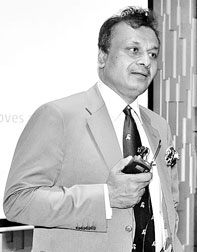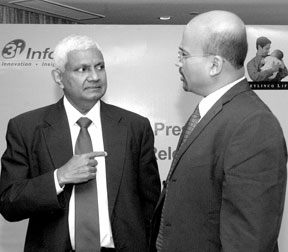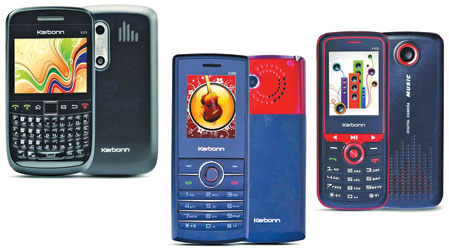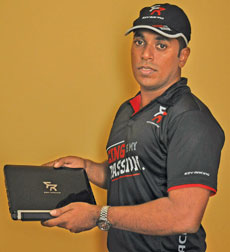TECHNOLOGY
Reputation based cyber security vital:
286 million malicious software detected in 2010 - Symantec
by Omar Rajarathnam
The threat landscape of cyber security has changed drastically and
software companies the world over are devising strategies to mitigate
this threat, Managing Director for India and SAARC region of Symantec
Ajay Goel told the Sunday Observer. Symantec is the fourth largest
software company in the world.
 |
|
Managing Director of Symantec for
India and SAARC region Ajay Goel at the ESPP presentation. |
“Sri Lanka is undergoing rapid development and the role of
Information Communication Technology (ICT) in steering these
developments are immense. Therefore, it is imperative that users are
subject to reputation based cyber security”, he said.
Ajay Goel was in the country to introduce the Enhanced Symantec
Partner Program (ESPP) which would enable Symantec’s Sri Lankan partner
South Asian Technologies (Pvt) Limited (sat) to have access to
Symantec’s product and solution content and be provided marketing
support aiming at increasing sat’s technical and operational efficiency
and service excellence.
The dawn of this millennium was threatened by the Y2K virus and this
marked Sri Lankan users being more alert about computer bugs.
However, times have changed and cyber attacks now target specific
information aiming at calculated gains.
“The value of information stolen in 2009 was estimated to be USD one
trillion caused mostly by employees who had resigned.
There is a crucial need for information, identity and security
management because the world has moved away from being system centric
and is becoming information driven and we must acknowledge that Sri
Lankan users have made steady progress in becoming aware of these
threats and have proactively mitigated the risk of being exploited”,
Goel said.
“Symantec has developed its own Global Intelligence Network with
thousands of experts who monitor online conduct of users, combined
technology to protect information through our software such as Norton
anti-virus which has approximately 120 million subscribers and
encouraged the introduction of policy and governance in industries
thereby getting them involved in counter attacking these threats”.
“These policies are a necessity in ensuring information security,” he
said.
Almost every organisation in the world offers mobile phones, laptops
and creating the need for mobile consumerisation of Information
technology (IT), but failure to regulate these tasks through policies is
the foundation to compromising on security.
Ensuring authentication avenues on these devices are not sufficient
but monitoring compliance with them is every organisation’s
responsibility”, he said.
Ceylinco Life upgrades to Kastle Treasury
By Sapumali Galagoda
Ceylinco Life will be upgraded to the latest version of 3i Infotech’s
Kastle Treasury Solution, it was announced last week.
3i Infotech is a global provider of IT solutions and one of India’s
largest software product developers.
 |
|
MD/CEO Ceylinco Insurance R.
Renganathan and Regional Head South Asia 3i infotech V.
Narayan.
Pic: Chinthaka Kumarasinghe |
Kastle Treasury is an integrated treasury management solution for
foreign exchange, money, equity, and their related derivative
instruments.
3i Infotech is a leading provider of technology solutions to the
banking, financial services,insurance, manufacturing, healthcare,
telecom, retail and the government.
The company is one of the top three indian software product
companies.
Ceylinco Life decided to upgrade its product to the latest version of
kastle Treasury to meet the demands of its investment department and to
manage the financial assets in various funds, said R. Renganathan.
Significant features of the product is its inherent compliance with the
Sri Lankan regulatory requirements which facilitates Ceylinco to
go-to-market strategy giving it a competitive edge.
3i Infotech is present in 14 countries - USA, UK, India, Bangladesh,
Kenya, Saudi Arabia, UAE, Bahrain, Kazakhastan, Singapore, Malaysia,
Thailand, Australia and China. The company has a revenue of $550 Mn.
Revenue for the company segment wise 72 per cent from IT solutions and
28 per cent from transaction services and Geography wise 56 per cent
from developed markets and 44 percent from emerging markets.
The company offers solutions for IP, IT services such as Business
intelligence and data warehousing, E-commerce, Enterprise Application
Integration, Enterprise Document Management Systems, Enterprise
Applications, Testing Services, application development and maintenance
services, infrastructure Management Services and for Business Process
Outsourcing/ IT Enabled Services.
3i Infotech gives rich domain and technology expertise, proficiency
in handling large and complex projects, scalability and flexibility in
operations, long term sustainability and financial stability, resource
skills and certifications, ability to deliver globally with cost
arbitrage, best people and process practices.
ITI’s ETL awarded ISO 17025 certification
by Omar Rajarathnam
The Electro Technology Laboratory (ETL) of the Industrial Training
Institute (ITI) has been awarded the ISO/TEC 17025:2005 accreditation
for its noise related Services. “This is the first time a Sri Lankan
laboratory engaged in noise related services and field testing has been
granted this certification” Head of Electro technology Laboratory of
ITI, A.S Pannila told the Sunday Observer.
Legislation requires all players in the manufacturing industry and
certain sectors of the hospitality sector obtain an Environment
Protection Licence prior to setting up operations.
One of the main parameters of assessment is the measurement of noise
pollution caused by the applicants’ industry and this is where ETL’s
noise related services are sought
“This is a highly defined scope of accreditation with strict
guidelines.
We have received the accreditation for ‘environment noise level
measurement’ which involves outdoor noise measurement and “industrial
noise level survey” which measures the occupational noise hazard
in-house.
The certification also covers our process of ‘performance test for
sound level meter’, ‘monitoring of background noise levels and existing
noise levels’ and ‘performance test for vibration level metre’, said
Pannila.
Having standard and accurate instrumentation, having trained staff to
operate those instruments and international calibration traceability
were the three imperatives were essential to be considered for this
accreditation.
“We have calibrations with laboratories in South Korea and Denmark
and hence it eased off the international traceability factor. Most of
our laboratories have world-class equipment and we have committed staff
working flexible shifts at various times that noise exists at sites thus
earning us this accreditation.”
“We have invested heavily on the equipment and, therefore, we
endeavour to optimise our investment by conforming to global standards
of testing where possible.”
The stringent legislation has caused many industries to appoint
safety officers strategising reductions in pollution”, he said.
“We also recommend affordable solutions to customers depending on the
scale of the industry helping us achieve the objective of ensuring
minimal harm to the public from noise pollution.
This would help the economy grow and ensure that industrial workers
and the wider population do not suffer adverse effects of noise or any
other environmental pollution”, Pannila said.
Storage maps, the future of digital data
by Ahsen Javed
The one consistent theme in the digital world is that growth is a
constant. It is estimated that from 2009 to 2020, the size of the
digital universe will have increased 44 fold; a 41 percent increase in
capacity every year. Storing, locating and extracting value from high
volumes of data will become increasingly complex.
As the digitally-enabled business world evolves, the mix of data and
its anticipated usages are going to change as well.
Already, there is an increased diversity of data types with 80
percent of today’s data being unstructured and the reuse of data is
shrinking, with 80 percent of data never being used after 90 days.
However, regulation and compliancy dictates that data is adequately
archived for long periods of time, sometimes up to triple digits in
number of years.
The fall out of the way data storage is currently handled is massive
- the impact on the environment is one of these factors. Storage already
consumes 40 percent of datacentre power and it is predicted that within
10 years the total energy consumed by storage solutions could increase
to more than six times what it is today.
Based on these predictions, storage could represent over 75 percent
of the energy consumed within the datacentre and if you consider that 80
percent of data is never looked at again after three months, storage is
a major IT trigger for energy burn out.
Another fallout is cost and the added expense of managing growing
volumes of data.
The business critical nature of data is driving up storage management
costs by 25 percent per year, so in the long term it will become the
number one cost within many datacentres.
Therefore, it’s becoming increasingly more important to align the
value of data with the capabilities and cost of the storage it is stored
on.
Looking forward, the future of storage management must be simple,
easily accessible, cost efficient, environmentally friendly and
streamlined, so organisations can function and perform quicker and
better.
Striving for nirvana
There are three essential elements that must be considered when
formulating a storage strategy to meet growing data demands - the
evolving function of the datacentre, business drivers, and the ‘nirvana’
storage solution.
Today’s typical datacentre is migrating from a physical, static, and
heterogeneous set-up, to a grid-based virtualised infrastructure to a
cloud computing environment that enables self service, policy-based
resource management, and capacity planning.
Along the way, the storage solution must be able to support this
style of datacentre, so it is critical that the storage system is
dynamic enough to support the difficult to predict demands of these
application environments through a tiered approach.
Reducing cost was at the top of the CIO’s agenda yesterday, now
business growth and profitability is.
The storage strategy must fall in line with these objectives. So,
regardless of an organisation’s size, the storage solution must be able
to scale to solve the larger, more complex business problems and it has
to perform in real-time so organisations can react and make business
decisions immediately.
Likewise, the infrastructure has to be efficient so complex business
problems can be effectively solved at a reduced cost and improved speed,
and there must be data integrity built in to meet long-term business and
regulatory compliancy. Finally, there is the liberating act of creating
a ‘storage nirvana’, should cost and incumbent infrastructure not be an
object.
For a CIO, this would probably include on-demand secure data access,
application aware storage optimisation, unlimited capacity, scalable
performance, appliance-like rapid deployment, and integrated
application, system and storage management.
Although, this nirvana is a distance away, these ideas must be taken
into consideration to guide organisations onto a path of accelerated
performance, profitability and lower IT costs.
A pyramid strategy
To make the strategy a reality, companies must shift away from the
traditional approach of managing islands of storage and move to an
automated, tiered and unified storage infrastructure.
By adopting a formula whereby certain data to be stored is assigned
to certain storage pools, organisations will improve the price,
performance, capacity and functionality of their storage infrastructure.
A typical tiered storage model has four tiers. Newly emerged, tier 0
uses flash memory storage, is extremely high performing and stores high
value information that needs to be captured, analyzed and presented at
high speed.
Primary storage, classified as tier 1, is based on fiber channel disk
systems and should have high performance, high availability with near
zero-downtime and fast recovery to support customer-facing and
revenue-based applications.
Tier 2 storage should be managed on low cost high capacity disks,
with the capability to manage broad business applications such as
databases, backup, email, and file systems. Finally, tier 3, which is
based on the more cost effective, energy efficient tape technology
serves the purpose to store high volume archival data for regulatory
purposes and doesn’t require immediate access.
To optimise the tiered storage architecture, companies must classify
and value the data of the business, then map and assign it to the
best-fit tier.
Data can be classified into four categories with I/O intensive data,
being assigned to tier 0 storage; mission critical data, such as revenue
and customer based applications to tier 1; vital data that doesn’t
require immediate recovery for the business to continue operating to
tier 2; and archival data with low activity, long term retention periods
to tier 3.
Leveraging economic prosperity
Leveraging upon a tiered storage environment has significant economic
advantages.
Research has shown that a single tiered storage environment has an
average lifetime cost of $15,000 per terabyte; a dual tiered one of
$8,000 per terabyte; and a four tiered storage structure, $4,000 per
terabyte.
With the majority of the data residing in the archival data tier 3,
which is built on tapes, costs will naturally depreciate.
Likewise, an automated systematic data-value mapping and distribution
approach requires less administration and maintenance at the low end of
the storage pyramid, thus reducing costs and freeing up staff time to
focus on the mission critical data.
Such an approach to storage also reduces compliancy risk and improves
business continuity as organisations will be able to more easily satisfy
legal and audit requirements, which in turn, improves service levels.
Ultimately, organisations will witness their performance improve as
upgrades will become easier, stale data will be removed from production
resources and there will be less disruption to the production
environment.
With growth, performance and profitability high on the C-level
agenda, storage management can play a significant role in helping
organisations to achieve these objectives.
(The writer is Managing Director, Oracle Pakistan and South Asia
Growth Economies, Pakistan)
PCH introduces two Karbonn mobile phones
With the successful introduction of the K25 Karbonn mobile phone, PCH
is now offering two new models of the Karbonn brand- K406 and K316. The
Karbonn mobile phone is India’s fastest growing brand selling over half
a million handsets per month across India.
 The Karbonn K406 is a dual SIM music phone equipped with an array of
stylish and attractive features. The Karbonn K406 is a dual SIM music phone equipped with an array of
stylish and attractive features.
The phone promises to be a treat for music lovers, with its hi-fi
audio output FM as well as MP3 playback and crystal clear loudspeaker
feature.
The phone supports MP3 and MIDI formats of music (Midi, MP3, MP2,
AAC, AMR-NB, Melody, AMR-WB, AAC+, eAAC).
The dual SIM Karbonn K316 mobile phone’s features include 1.77
inches, TFT 65K colour display screen with 120 x 160 pixel of screen
resolution and FM radio with recording facility. The phone allows up to
2GB of external memory along with micro SD/T-Flash memory card slots.
COO, Mobile Handset Division PCH Failan Saleem said,”The Karbonn K406
and K316 are for today’s music lovers who like to carry their music with
them.
These phones are powered by hi-fi sound output and a high quality
audio experience and is sure to appeal to music enthusiasts as well as a
generation of mobile users who depend on quality and product appeal.”
With dual SIM phones are gaining popularity in the rural market,
Failan foresees a huge opportunity for these new phones. “ Apart from
the benefit of having different numbers for different purposes,
especially where a local SIM can take care of outgoing calls and the
roaming capability of the other SIM could be used for receiving calls,
the phones are backed by a proper warranty,” he said.
Launch of ‘EZY Racing’ limited edition laptop
The EZY Racing limited edition laptop was introduced to the local
market recently. EZY Racing (ER), is the racing brand of EZY Motor
Racing Corporation (EMRC), a fully owned subsidiary of computer giant
EZY Holdings.
 |
|
Rally Champion Shafraz Junaid displays
the EZY Racing limited edition laptop. |
The first machine of this special edition laptop [of which only 500
numbers have been manufactured] was presented to EZY racer Shafraz
Junaid, the 2010 Rally Championship winner.
“We have launched the EZY Racing limited edition laptop as a tribute
to our winning Rally Championship team”, said Hamzadeen of EMRC.
“2010 was a very successful year for EMRC. We were not only
successful in winning the Team Rally Championship, but we also won the
Driver’s Championship for the 2nd successive year.
This limited edition laptop is our tribute to the dedication and
commitment shown by our team and our drivers, and we hope that IT
connoisseurs as well as motor enthusiasts will appreciate this product”.
The first of these series of laptops is the ER 3 laptop [named in
recognition of the 2010 Drivers Championship winner Shafraz Junaid and
his car].
EZY intends launching the ER 6 laptop, named in honour of the 2010
Foxhill Super Cross winner Sajaad Zuhair, and the ER 9 laptop, named
after the 2009 Rally Champion, Rizvi Farouk.
The ER3 Laptop which is a mere 10 inches, makes it ultra-portable, is
powered by an Intel N450 motherboard with a 1.66 Ghz processor.
The ER 3 provides its users with extra memory by way of a 2GB memory
card and a 250GB hard drive and comes packed with Bluetooth, wireless,
an external card reader, as well as a 1.3MP camera.
Oma Emirates ties up with Epic Lanka
Oma Emirates LLC, a leading provider of software solutions to the
global payment card industry tied up with Sri Lanka’s premier software
solutions provider Epic Lanka under an exclusive agreement. This
partnership will enable the two companies to share expertise, co-develop
solutions and also benefit from marketing opportunities in the new
territories.
Oma Emirates LLC offers products to the global payment card industry
covering terminal management, EFT POS applications, EMV card
personalisation and central issuance systems. In partnership with
several global brands of equipment suppliers they dominate the Middle
East market where the majority of the banks are their regular clients.
“The partnership will assist the migration process to EMV where
personalisation would be done locally.
|

